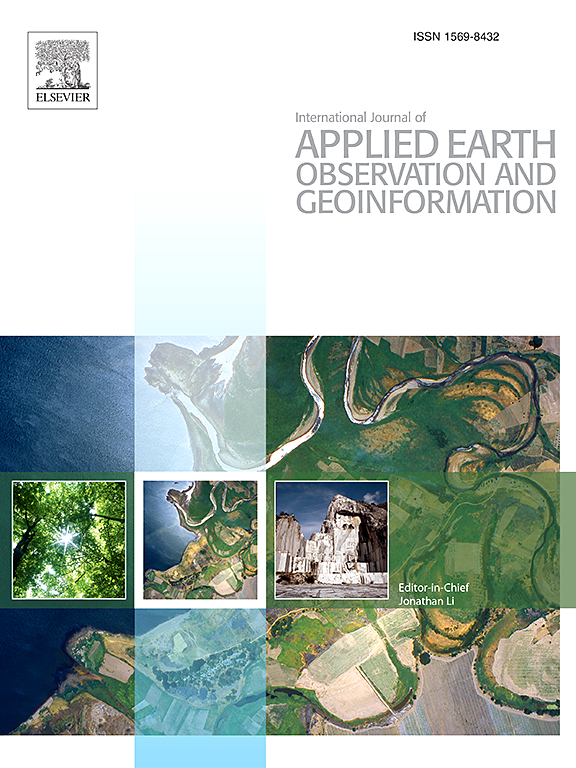Automated crevasse mapping for Alpine glaciers: A multitask deep neural network approach
IF 7.6
Q1 REMOTE SENSING
International journal of applied earth observation and geoinformation : ITC journal
Pub Date : 2025-03-25
DOI:10.1016/j.jag.2025.104495
引用次数: 0
Abstract
Glacier crevasses are fractures in ice that form as a result of tension. Information on the location of crevasses is important for mountaineers and field researchers to plan a safe traverse over a glacier. Today, Alpine glaciers change faster than cartography can keep up with up-to-date manually created maps on crevasse zones. For the first time, this study presents an approach for automated crevasse mapping from high-resolution airborne remote sensing imagery based on a multitask deep neural network. The model was trained and evaluated over seven training and six test areas located in the Oetztal and Stubai Alps. By simultaneously preforming edge detection and segmentation tasks, the multitask model was able to robustly detect glacier crevasses of different shapes within different illumination conditions with a balanced accuracy of 86.2 %. Our approach is applicable to large-scale applications as demonstrated by creating high-resolution crevasse maps for the entire Oetztal and Stubai Alps for the years 2019/2020. Spatial and temporal transferability was proven by creating high-quality crevasse maps for all glaciers surrounding Großglockner, Piz Palü, and Ortler. The here presented datasets can be integrated into hiking maps and digital cartography tools to provide mountaineers and field researcher with up-to-date crevasse information but also inform modelers on the distribution of stress within a glacier.
高山冰川自动裂缝制图:一种多任务深度神经网络方法
冰川裂缝是由于冰的张力而形成的裂缝。关于冰川裂缝位置的信息对于登山者和野外研究人员计划安全穿越冰川非常重要。如今,阿尔卑斯冰川的变化速度已经快到制图学无法跟上最新的人工绘制的裂缝区地图。本研究首次提出了一种基于多任务深度神经网络的高分辨率航空遥感图像裂缝自动测绘方法。该模型在位于Oetztal和Stubai阿尔卑斯山的七个训练区和六个测试区进行了训练和评估。通过同时执行边缘检测和分割任务,该多任务模型能够在不同光照条件下对不同形状的冰川裂缝进行鲁棒检测,平衡精度达到86.2%。我们的方法适用于大规模应用,例如在2019/2020年为整个Oetztal和Stubai阿尔卑斯山创建高分辨率裂缝地图。通过为Großglockner、Piz Palü和Ortler周围的所有冰川创建高质量的裂缝地图,证明了空间和时间的可转移性。这里展示的数据集可以集成到徒步旅行地图和数字制图工具中,为登山者和实地研究人员提供最新的裂缝信息,同时也为建模者提供冰川内部应力分布的信息。
本文章由计算机程序翻译,如有差异,请以英文原文为准。
求助全文
约1分钟内获得全文
求助全文
来源期刊

International journal of applied earth observation and geoinformation : ITC journal
Global and Planetary Change, Management, Monitoring, Policy and Law, Earth-Surface Processes, Computers in Earth Sciences
CiteScore
12.00
自引率
0.00%
发文量
0
审稿时长
77 days
期刊介绍:
The International Journal of Applied Earth Observation and Geoinformation publishes original papers that utilize earth observation data for natural resource and environmental inventory and management. These data primarily originate from remote sensing platforms, including satellites and aircraft, supplemented by surface and subsurface measurements. Addressing natural resources such as forests, agricultural land, soils, and water, as well as environmental concerns like biodiversity, land degradation, and hazards, the journal explores conceptual and data-driven approaches. It covers geoinformation themes like capturing, databasing, visualization, interpretation, data quality, and spatial uncertainty.
 求助内容:
求助内容: 应助结果提醒方式:
应助结果提醒方式:


